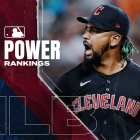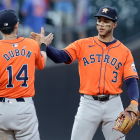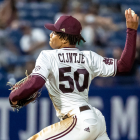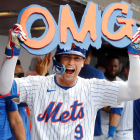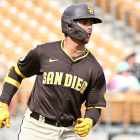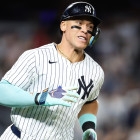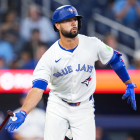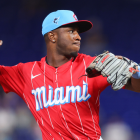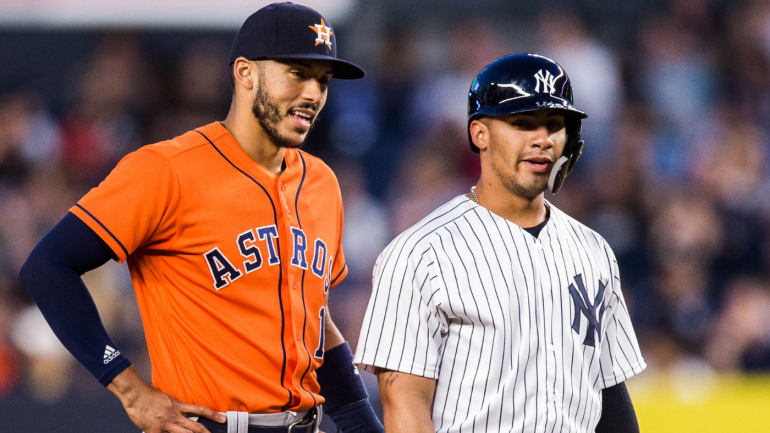
The holidays are upon us and this is usually the slow time of the offseason. The few weeks between the Winter Meetings and New Years are often quiet. This year there is radio silence. The owners' lockout has halted all meaningful hot stove activity, and seeing how MLB and the MLBPA aren't expected to discuss core economic matters until January, it will remain quiet another few weeks.
Whenever the lockout ends, there will be a relatively short period of time in which teams must wrap up all their offseason business (that includes arbitration signings and the Rule 5 Draft in addition to any trades and free-agent deals) before spring training. Some teams have more to do than others. A lot more. Not every club was active during the pre-lockout free agent frenzy.
With that in mind, here are the 10 teams with the most work to do once MLB and the MLBPA agree to a new collective bargaining agreement, ending the lockout. The 10 teams are ranked in order of just how much work they have to do, and how much that work will impact their 2022 season outlook.
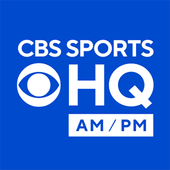
CBS Sports HQ Newsletter
Your Ultimate Guide to Every Day in Sports
We bring sports news that matters to your inbox, to help you stay informed and get a winning edge.
Thanks for signing up!
Keep an eye on your inbox.
Sorry!
There was an error processing your subscription.
1. New York Yankees
Biggest needs: Shortstop. Also the outfield, first base, rotation, and maybe catcher
The Yankees sat out the pre-lockout portion of the offseason and as a result have a full to-do list waiting for them once the lockout ends. Shortstop is the most glaring need because the Yankees literally do not have one at the moment, unless you count third baseman Gio Urshela, who played short after the team pulled the plug on Gleyber Torres at the position in August.
Given their financial might, the Yankees should just sign Carlos Correa, a 27-year-old who is one of the 2-3 best players in the world at his position. If not Correa, then Trevor Story. The shortstop options beyond those two are unappealing glove-first stopgap types who would not move the needle much for a team that ranked 10th in the American League in runs scored in 2021.
New York's needs do not end there though. The Yankees seem set on moving on from Luke Voit in an effort to diversify their lineup with more lefty bats. That means first base is an open question. Aaron Hicks' injuries create a need in the outfield, and another starter to knock Nestor Cortes Jr. and Domingo Germán down a peg on the depth chart would be nice too. Upgrading on Gary Sánchez behind the plate will be difficult given the catching market, though that's something they've explored as well.
How much will the Yankees spend? That part is unclear. Ownership has prioritized staying under the luxury tax in recent years and the team's pre-lockout inactivity suggests the Yankees are waiting to see what the new CBA does to the sport's economic structure before committing future dollars. Either way, New York's post-lockout shopping list is the longest among contenders.
2. Los Angeles Dodgers
Biggest needs: Rotation depth
It is still a bit stunning the Dodgers let Max Scherzer leave given how excellent he was down the stretch, at least until he got worn down come postseason time. Scherzer's contract with the Mets is exorbitant (three years and $120 million) but it's not like the Dodgers couldn't afford it. Now the team that appeared to have too much pitching last spring is in need of depth behind Walker Buehler and Julio Urías.
Clayton Kershaw's return is not a given -- his hometown Rangers are seen as a legitimate threat to sign him -- but, even if he does return, it's difficult to know how much he'll contribute. He twice dealt with forearm issues in 2021, a common precursor to Tommy John surgery, and Kershaw reportedly wants to see how he responds this offseason before making a decision about his future.
The Dodgers signed Andrew Heaney to a low cost one-year deal early in the offseason and he fits their mold as an upside guy, even if he won't necessary pitch deep into games. Carlos Rodón, the best available free agent starter, is a (much) better version of Heaney and would fit as well. Signing Rodón and re-signing Kershaw would be the perfect world scenario, I think. Los Angeles has the prospect depth to swing any trade (Luis Castillo?), so that's another possibility.
Bottom line, the Dodgers need more rotation depth with David Price best suited for the bullpen at this point in his career (and there's no sense in counting on Trevor Bauer). Re-signing or replacing Kenley Jansen also figures to be on the offseason agenda, and the Dodgers will at least need to think about how they'll handle the universal DH once the new CBA makes it permanent.
3. Philadelphia Phillies
Biggest needs: Left side of the field, center field
Similar to the Yankees, the Phillies more or less sat out the pre-lockout portion of the offseason, with a one-year contract for righty reliever Corey Knebel their only move of note. Given the seasons they just had, it's hard to see the Phillies running Didi Gregorius and Alec Bohm back out there at shortstop and third base, respectively. They don't have left or center fielders either.
Filling all four positions in a meaningful way will be difficult given the expected post-lockout time crunch. Teams might only have 2-3 weeks between the end of the lockout and the start of spring training to get their affairs in order. Sticking with Bohm (and moving him to left field?) would be defensible given his pedigree as a top prospect and high draft pick. I'm a Matt Vierling fan and would be curious to see how he handles a full-time lineup spot in either left or center field, but I'm not sure the team agrees.
Clearly though, the Phillies badly need to improve their defense on the left side of the infield, and lengthen their lineup. And they have to do it with several big-money contracts already on the books. Those big-money players (Bryce Harper, JT Realmuto, Zack Wheeler) are the reasons the Phillies hung around the postseason race in 2022. They're not the problem. The supporting cast is.
Prior to the lockout the Phillies were connected to free agents Kris Bryant (Harper's longtime pal) and Kyle Schwarber, and trade candidate Kevin Kiermaier. Spending money would be preferable to giving up prospects, though that's not possible with the center field market at this point. The Phillies are in a difficult spot with a lot of needs, few avenues to address them, and little time to do it.
4. Oakland Athletics
Biggest needs: Cutting payroll, apparently
All signs point to the A's slashing payroll this offseason. They let manager Bob Melvin go to the Padres for no compensation even though he had another year remaining on his contract, and they declined their sensible $4 million club option for lefty reliever Jake Diekman. More cost-cutting is expected as the team further positions itself to threaten relocation if it doesn't get a new ballpark.
"We don't have an exact direction yet," GM David Forst told reporters, including USA Today's Bob Nightengale, at the GM Meetings last month when asked whether a rebuild is coming. "But you look at our history, and we have three- or four-year runs and recognize where we are makes it necessary to step back. But we have not gotten to that point yet with ownership. Until that plan is really there, it's hard to sort of time everything out."
Assuming the Athletics stick to the cost-cutting plan, their post-lockout activity will revolve on who they move out, not who they bring in. The most obvious trade chips are rental starters Chris Bassitt and Sean Manaea, but others with control beyond 2022 like Matt Chapman, Tony Kemp, Ramón Laureano, Frankie Montas, and Matt Olson would garner plenty of interest as well.
Teams can discuss trades involving 40-man roster players during the lockout but they can not consummate them. It is possible, if not likely, Forst & Co. are working the phones right now and will have trades lined up whenever the work stoppage ends. If the A's are going to scale back as much as expected, they figure to be one of the busiest teams in baseball post-lockout.
5. Seattle Mariners
Biggest needs: Rotation depth, a big bat
Landing reigning AL Cy Young winner Robbie Ray was a coup. He joins Chris Flexen, Logan Gilbert, and Marco Gonzales to form a promising rotation top four. Post-hype youngsters Justin Dunn and Justus Sheffield are still around and prospects Matt Brash, Emerson Hancock, and George Kirby will arrive sooner rather than later. Ray knocks everyone down a peg into a more appropriate spot on the depth chart.
Even with Dunn and Sheffield available and the kids on the way, the Mariners still want more rotation depth, reports The Athletic's Corey Brock. They don't need an ace or even a high-end No. 2 starter. Just someone to solidify the back of the rotation and reduce how much the club has to rely on young arms. A reunion with free agent lefty Tyler Anderson would make sense.
The Mariners also need a legitimate middle-of-the-order bat. They already traded for Adam Frazier, but need someone better than that to fill the DH spot or third base. Intradivision trades are always tricky, though you can an envision a one-stop shop trade with the A's that sends, say, Matt Chapman and Sean Manaea to Seattle. Kris Bryant and Trevor Story can't be ruled out as possibilities.
I don't think it will happen but a Nelson Cruz reunion would be neat. He'd fill the DH spot and provide middle-of-the-order thump, plus he's a top-notch clubhouse guy who would help mentor Seattle's young players. Cruz has a history with the organization and might relish the opportunity to be part of the Mariners team that ends the postseason drought. Just a thought.
6. Atlanta Braves
Biggest needs: First base
The Braves handled some of their most pressing offseason business during the season, when they signed righty Charlie Morton and catcher Travis d'Arnaud to contract extensions. They also brought in backup catcher Manny Piña as a free agent this winter. The reigning World Series champs can also look forward to Ronald Acuña Jr. and Mike Soroka returning sometime in 2022.
From this point forward, Atlanta's offseason revolves around one player: Freddie Freeman. The Braves did not lock up the franchise icon first baseman before the lockout and that's a bit of a stunner. I expected Freeman to be among the first free agents to sign. He is said to be seeking six years and $180 million while the team holds firm with a five-year offer. That gap seems bridgeable.
Should Freeman sign elsewhere (I think it's unlikely, but humor me), the Braves would have no shortage of replacement first base options. Trading for Matt Olson would be ideal. They could also sign Anthony Rizzo or crash-course first baseman Kyle Schwarber, trade for Luke Voit, or do something creative like bring in Kris Bryant and move Austin Riley over to first. There are options.
That said, the Braves should just re-sign Freeman. He's building a pretty solid Hall of Fame case and he's already in retired number territory with the Braves. He's the player they held onto during the rebuild and he rewarded their faith with a World Series this year. Some players should spend their entire careers with one team. Freeman is one of them. Get it done, Braves.
7. Toronto Blue Jays
Biggest needs: Infield, rotation depth
I'm not sure any team's arrow is pointing up as much as Toronto's right now. The Blue Jays have a powerhouse offense, four good to great starting pitchers (José Berríos, Kevin Gausman, Alek Manoah, Hyun-Jin Ryu), deep pockets, and a deep farm system. The Blue Jays were arguably the third best team in the American League in 2021 and it was no fluke. They're a force to be reckoned with.
That said, the Blue Jays did lose Marcus Semien to free agency. Replacing an MVP candidate is never easy, and frankly, it's often unrealistic. Toronto has the means and presumably the motivation to do it though. I'm not sure a big money long-term deal for, say, Carlos Correa or Trevor Story or Kris Bryant is in the cards with extensions looming for Vladimir Guerrero Jr. and Bo Bichette (and Teoscar Hernández?), but feel free to line up your trade targets:
- 3B José Ramírez, Guardians
- 2B/OF Ketel Marte, Diamondbacks
- 3B Matt Chapman, Athletics
All three are under control at affordable salaries for at least another two seasons, meaning they wouldn't create long-term payroll headaches, and Cavan Biggio and Santiago Espinal are versatile enough to make it all work. Bring in Chapman or Ramírez to play third, and Biggio/Espinal can play second. Bring in Marte for second base, and they can play third instead. Easy peasy.
The Yankees and Red Sox are hamstringing themselves with luxury-tax games and there will always be a limit to the Rays' upside given their shoestring operation. There is a clear path to AL East supremacy for the Blue Jays. Import an impact infielder (something they can do without dismantling their MLB core), solidify the back of the rotation, then go bully the rest of the division.
8. Texas Rangers
Biggest needs: Rotation, left field
No team made more noise pre-lockout than the Rangers, who added Corey Seager and Marcus Semien to the infield and Jon Gray to the rotation (and Kole Calhoun to the outfield). This was a 102-loss team in 2021 though, and there's still a ways to go before the Rangers can all themselves legitimate contenders. Realistically, 2023 is a better target for their coming out party. Not 2022.
Anyway, the rotation beyond Gray and Dane Dunning obviously needs reinforcement. AJ Alexy, Taylor Hearn, Spencer Howard, and Glenn Otto all showed promise in 2021, but you'd rather not count on all of them right out of the gate in 2022. Another veteran guy to chew up innings and potentially serve as a midseason trade chip would seem to be in the cards. Can't hurt, right?
Texas has had success helping veterans level up in recent years (Kyle Gibson, Lance Lynn, Mike Minor) and I'd be interested to see what they could do with Yusei Kikuchi, who has high-end stuff but poor results. It feels like there's a very good pitcher lurking under the surface, waiting to be unlocked. If not Kikuchi, then Michael Pineda or even Johnny Cueto could fit as innings guys.
Top prospect Leody Taveras hasn't hit in his limited MLB time, so right now Adolis García is in center and the left field job will go to some combination of Nick Solak, Zach Reks, and Eli White. Surely the Rangers can do better than that, no? They don't have to spend big, but respectability goes a long way. Tommy Pham or Corey Dickerson would work. For now, pitching is the top priority. Gray alone isn't enough.
9. Minnesota Twins
Biggest needs: Starting pitchers
Have you looked at Minnesota's rotation lately? It is shocking bad. Not even a healthy Kenta Maeda would make it respectable, and of course Maeda will miss 2022 while rehabbing from Tommy John surgery. Here, according to FanGraphs' 2022 projected WAR, are the Twins' top five starters at the moment:
- RHP Bailey Ober: 1.9 WAR
- RHP Joe Ryan: 1.8 WAR
- RHP Dylan Bundy: 1.2 WAR
- RHP Randy Dobnak: 0.8 WAR
- RHP Josh Winder: 0.4 WAR
Yikes. Winder has made only four starts above Triple-A and others like Griffin Jax, Lewis Thorpe, and top prospect Jordan Balazovic check in at replacement level. Projections are not the be-all, end-all, but the rotation picture is grim. At minimum, the Twins need an innings guy to lighten the load on Ober and Ryan, neither of whom has thrown as many as 125 innings in a season. They probably need two starters, maybe even three.
The shortstop position is open as well, though it's tough to see the Twins as legitimate contenders for Carlos Correa or Trevor Story. An Andrelton Simmons reunion isn't happening. Erstwhile Rangers shortstop Isiah Kiner-Falefa might be a more sensible target. No matter what the Twins do at short, they have little chance to contend with that rotation. It needs help. A lot of help.
10. New York Mets
Biggest needs: Rotation depth, bullpen
The Mets fortified their rotation (Max Scherzer) and lineup (Mark Canha, Eduardo Escobar, Starling Marte) prior to the lockout, so most of their major moves have been made. At this point there's not much left to do other than tinker and upgrade on the margins. The Mets have been derailed by a lack of viable big-league depth too many times in recent years. That must be corrected.
New York still has room for a back-end starter, someone to push Tylor Megill and David Peterson down the depth chart and to guard against Jacob deGrom's and Carlos Carrasco's injury concerns. The bullpen also needs one more high-leverage option, ideally a southpaw to neutralize those lefty hitting NL East titans like Bryce Harper and Juan Soto (and possibly Freddie Freeman again).
Teams these days lean toward upside with their back-end starters, suggesting Yusei Kikuchi and Michael Pineda could be targets for the Mets. Maybe Matthew Boyd if they're willing to wait until he recovers from flexor tendon surgery (expected back in the middle of 2022). Andrew Chafin and Jake Diekman are the top of the free-agent lefty reliever class at this point.
Honorable mentions
Boston Red Sox: The Red Sox were active prior to the lockout, bringing in three veteran starters (Rich Hill, Michael Wacha, James Paxton) and reuniting with Jackie Bradley Jr. Considering they gave up Hunter Renfroe to get Bradley and lost Eduardo Rodriguez to free agency, I'm not sure Boston actually improved. An outfield bat (Kyle Schwarber reunion?) and another bullpen arm should be on the post-lockout to-do list.
Los Angeles Angels: The Angels still need more pitching even after signing Michael Lorenzen and Noah Syndergaard, and re-signing Raisel Iglesias. They also need a middle infielder, with free agency offering more at second base (Josh Harrison?) than shortstop. David Fletcher's ability to play second or short gives the Halos the ability to pursue upgrades at either position.
San Diego Padres: After running so short on pitching that they had to sign Jake Arrieta and Vince Velasquez off the scrap heap late in 2021, the Padres spent the pre-lockout portion of the offseason adding pitching depth (Luis García, Nick Martinez, Robert Suarez). They could still use another high-leverage reliever to replace Mark Melancon, and with the universal DH on the way, another outfield bat would be smart. It seems likely San Diego's biggest addition this offseason will be manager Bob Melvin, who replaced the overmatched Jayce Tingler.
San Francisco Giants: Will the Giants really go with Joey Bart behind the plate to replace Buster Posey? The catching market is awful, so that might be the best way to go. I trust the Giants to figure out their rotation, though the No. 5 spot is begging for an upgrade with Tyler Beede entering his first full season back from Tommy John surgery. Don't sleep on them swinging a cross-Bay trade with the A's to bring in Chris Bassitt or Sean Manaea.
Washington Nationals: In all likelihood 2022 will be a lean year for the 2019 World Series champs. That doesn't mean the Nationals can completely sit out the offseason though. They need rotation depth to protect against Stephen Strasburg's health and their young arms -- given their tendency to target veteran starters, I wonder if this is where Zack Greinke lands -- and a left field bat wouldn't hurt either.










